A Report on the Effects of Social Media on Children's Development
VerifiedAdded on 2022/01/08
|7
|1249
|55
Report
AI Summary
This report examines the effects of social media on children, focusing on the negative impacts of prolonged exposure. It discusses how social media use is linked to increased rates of depression and anxiety, affecting children's cognitive and social factors. The report explores the influence of social media on children's behavior, including increased aggression, influenced by media content such as action movies. It also addresses the role of social learning theory in explaining how children imitate behaviors observed online, leading to stereotypes and biases. The report references studies that highlight the impact of media on racial and gender stereotyping, and the development of mental health issues. The conclusion suggests the promotion of entertainment-mediated education through social media to convey positive messages and boost self-esteem.
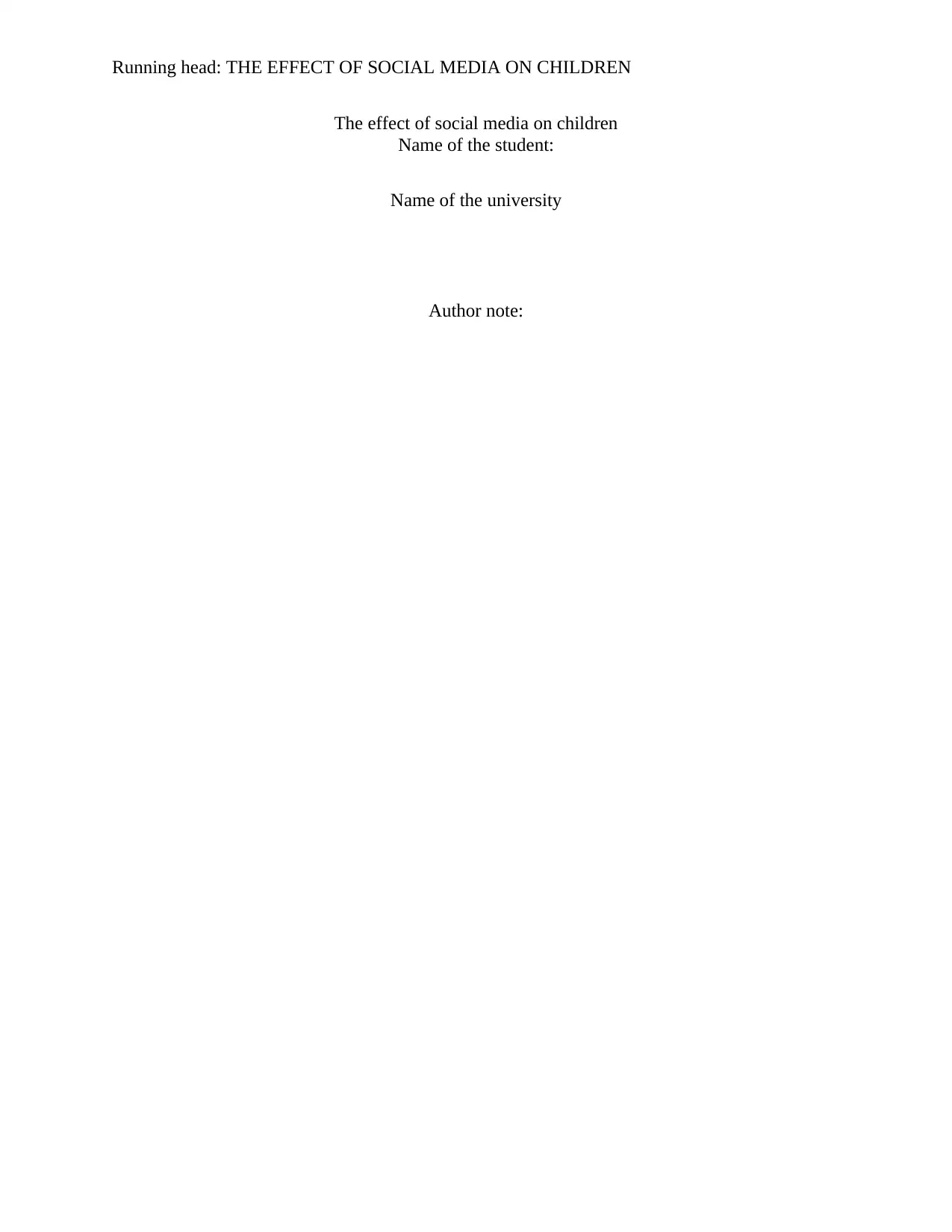
Running head: THE EFFECT OF SOCIAL MEDIA ON CHILDREN
The effect of social media on children
Name of the student:
Name of the university
Author note:
The effect of social media on children
Name of the student:
Name of the university
Author note:
Paraphrase This Document
Need a fresh take? Get an instant paraphrase of this document with our AI Paraphraser
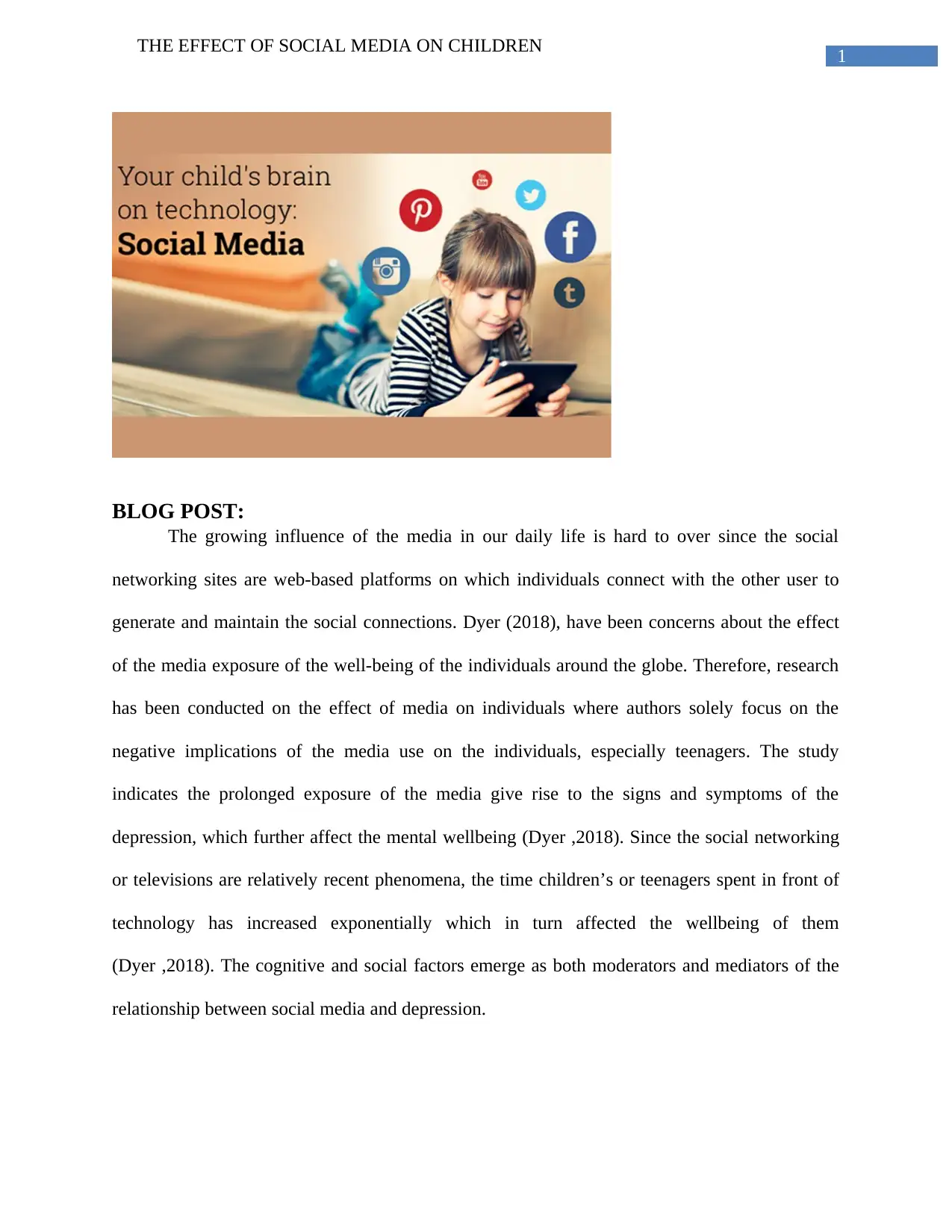
1
THE EFFECT OF SOCIAL MEDIA ON CHILDREN
BLOG POST:
The growing influence of the media in our daily life is hard to over since the social
networking sites are web-based platforms on which individuals connect with the other user to
generate and maintain the social connections. Dyer (2018), have been concerns about the effect
of the media exposure of the well-being of the individuals around the globe. Therefore, research
has been conducted on the effect of media on individuals where authors solely focus on the
negative implications of the media use on the individuals, especially teenagers. The study
indicates the prolonged exposure of the media give rise to the signs and symptoms of the
depression, which further affect the mental wellbeing (Dyer ,2018). Since the social networking
or televisions are relatively recent phenomena, the time children’s or teenagers spent in front of
technology has increased exponentially which in turn affected the wellbeing of them
(Dyer ,2018). The cognitive and social factors emerge as both moderators and mediators of the
relationship between social media and depression.
THE EFFECT OF SOCIAL MEDIA ON CHILDREN
BLOG POST:
The growing influence of the media in our daily life is hard to over since the social
networking sites are web-based platforms on which individuals connect with the other user to
generate and maintain the social connections. Dyer (2018), have been concerns about the effect
of the media exposure of the well-being of the individuals around the globe. Therefore, research
has been conducted on the effect of media on individuals where authors solely focus on the
negative implications of the media use on the individuals, especially teenagers. The study
indicates the prolonged exposure of the media give rise to the signs and symptoms of the
depression, which further affect the mental wellbeing (Dyer ,2018). Since the social networking
or televisions are relatively recent phenomena, the time children’s or teenagers spent in front of
technology has increased exponentially which in turn affected the wellbeing of them
(Dyer ,2018). The cognitive and social factors emerge as both moderators and mediators of the
relationship between social media and depression.
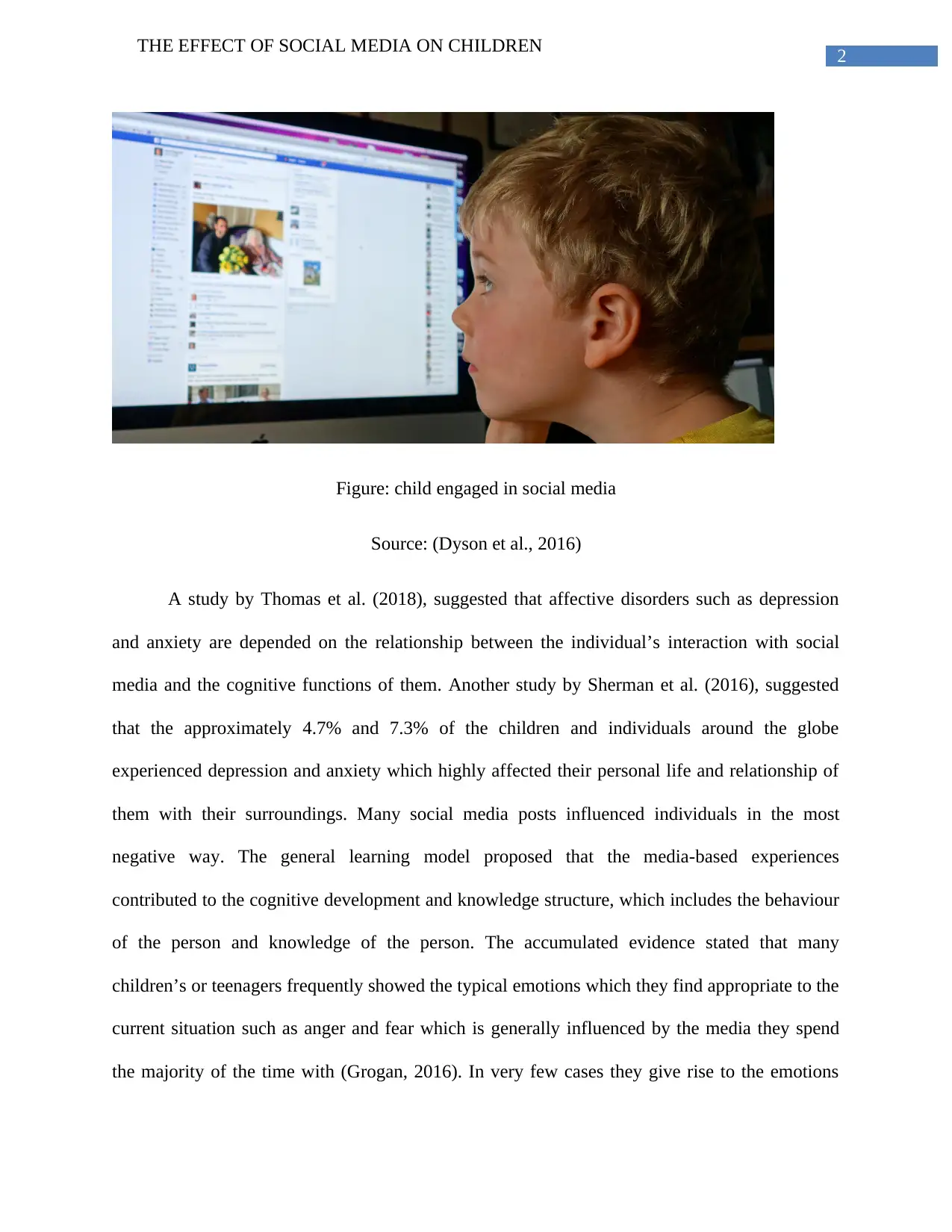
2
THE EFFECT OF SOCIAL MEDIA ON CHILDREN
Figure: child engaged in social media
Source: (Dyson et al., 2016)
A study by Thomas et al. (2018), suggested that affective disorders such as depression
and anxiety are depended on the relationship between the individual’s interaction with social
media and the cognitive functions of them. Another study by Sherman et al. (2016), suggested
that the approximately 4.7% and 7.3% of the children and individuals around the globe
experienced depression and anxiety which highly affected their personal life and relationship of
them with their surroundings. Many social media posts influenced individuals in the most
negative way. The general learning model proposed that the media-based experiences
contributed to the cognitive development and knowledge structure, which includes the behaviour
of the person and knowledge of the person. The accumulated evidence stated that many
children’s or teenagers frequently showed the typical emotions which they find appropriate to the
current situation such as anger and fear which is generally influenced by the media they spend
the majority of the time with (Grogan, 2016). In very few cases they give rise to the emotions
THE EFFECT OF SOCIAL MEDIA ON CHILDREN
Figure: child engaged in social media
Source: (Dyson et al., 2016)
A study by Thomas et al. (2018), suggested that affective disorders such as depression
and anxiety are depended on the relationship between the individual’s interaction with social
media and the cognitive functions of them. Another study by Sherman et al. (2016), suggested
that the approximately 4.7% and 7.3% of the children and individuals around the globe
experienced depression and anxiety which highly affected their personal life and relationship of
them with their surroundings. Many social media posts influenced individuals in the most
negative way. The general learning model proposed that the media-based experiences
contributed to the cognitive development and knowledge structure, which includes the behaviour
of the person and knowledge of the person. The accumulated evidence stated that many
children’s or teenagers frequently showed the typical emotions which they find appropriate to the
current situation such as anger and fear which is generally influenced by the media they spend
the majority of the time with (Grogan, 2016). In very few cases they give rise to the emotions
⊘ This is a preview!⊘
Do you want full access?
Subscribe today to unlock all pages.

Trusted by 1+ million students worldwide
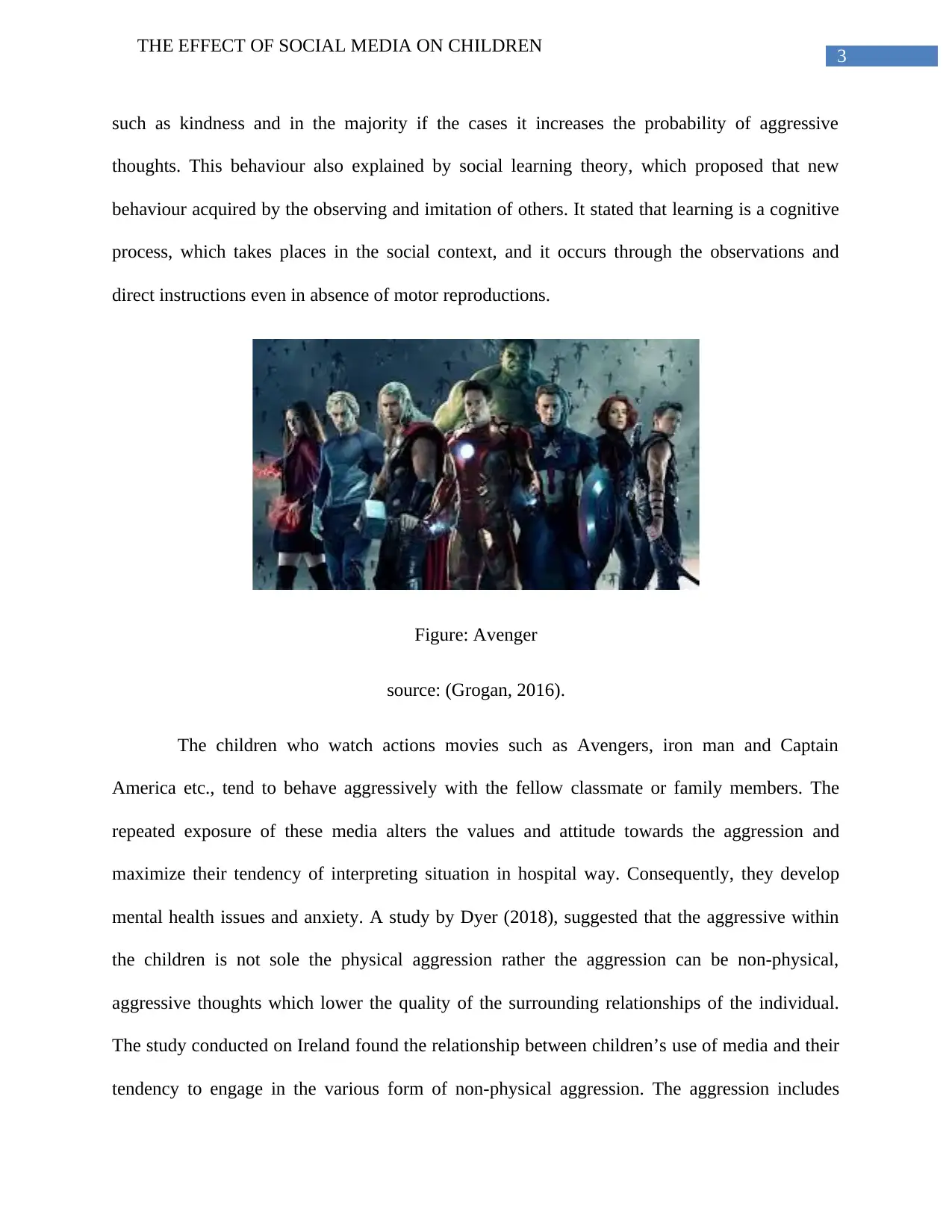
3
THE EFFECT OF SOCIAL MEDIA ON CHILDREN
such as kindness and in the majority if the cases it increases the probability of aggressive
thoughts. This behaviour also explained by social learning theory, which proposed that new
behaviour acquired by the observing and imitation of others. It stated that learning is a cognitive
process, which takes places in the social context, and it occurs through the observations and
direct instructions even in absence of motor reproductions.
Figure: Avenger
source: (Grogan, 2016).
The children who watch actions movies such as Avengers, iron man and Captain
America etc., tend to behave aggressively with the fellow classmate or family members. The
repeated exposure of these media alters the values and attitude towards the aggression and
maximize their tendency of interpreting situation in hospital way. Consequently, they develop
mental health issues and anxiety. A study by Dyer (2018), suggested that the aggressive within
the children is not sole the physical aggression rather the aggression can be non-physical,
aggressive thoughts which lower the quality of the surrounding relationships of the individual.
The study conducted on Ireland found the relationship between children’s use of media and their
tendency to engage in the various form of non-physical aggression. The aggression includes
THE EFFECT OF SOCIAL MEDIA ON CHILDREN
such as kindness and in the majority if the cases it increases the probability of aggressive
thoughts. This behaviour also explained by social learning theory, which proposed that new
behaviour acquired by the observing and imitation of others. It stated that learning is a cognitive
process, which takes places in the social context, and it occurs through the observations and
direct instructions even in absence of motor reproductions.
Figure: Avenger
source: (Grogan, 2016).
The children who watch actions movies such as Avengers, iron man and Captain
America etc., tend to behave aggressively with the fellow classmate or family members. The
repeated exposure of these media alters the values and attitude towards the aggression and
maximize their tendency of interpreting situation in hospital way. Consequently, they develop
mental health issues and anxiety. A study by Dyer (2018), suggested that the aggressive within
the children is not sole the physical aggression rather the aggression can be non-physical,
aggressive thoughts which lower the quality of the surrounding relationships of the individual.
The study conducted on Ireland found the relationship between children’s use of media and their
tendency to engage in the various form of non-physical aggression. The aggression includes
Paraphrase This Document
Need a fresh take? Get an instant paraphrase of this document with our AI Paraphraser
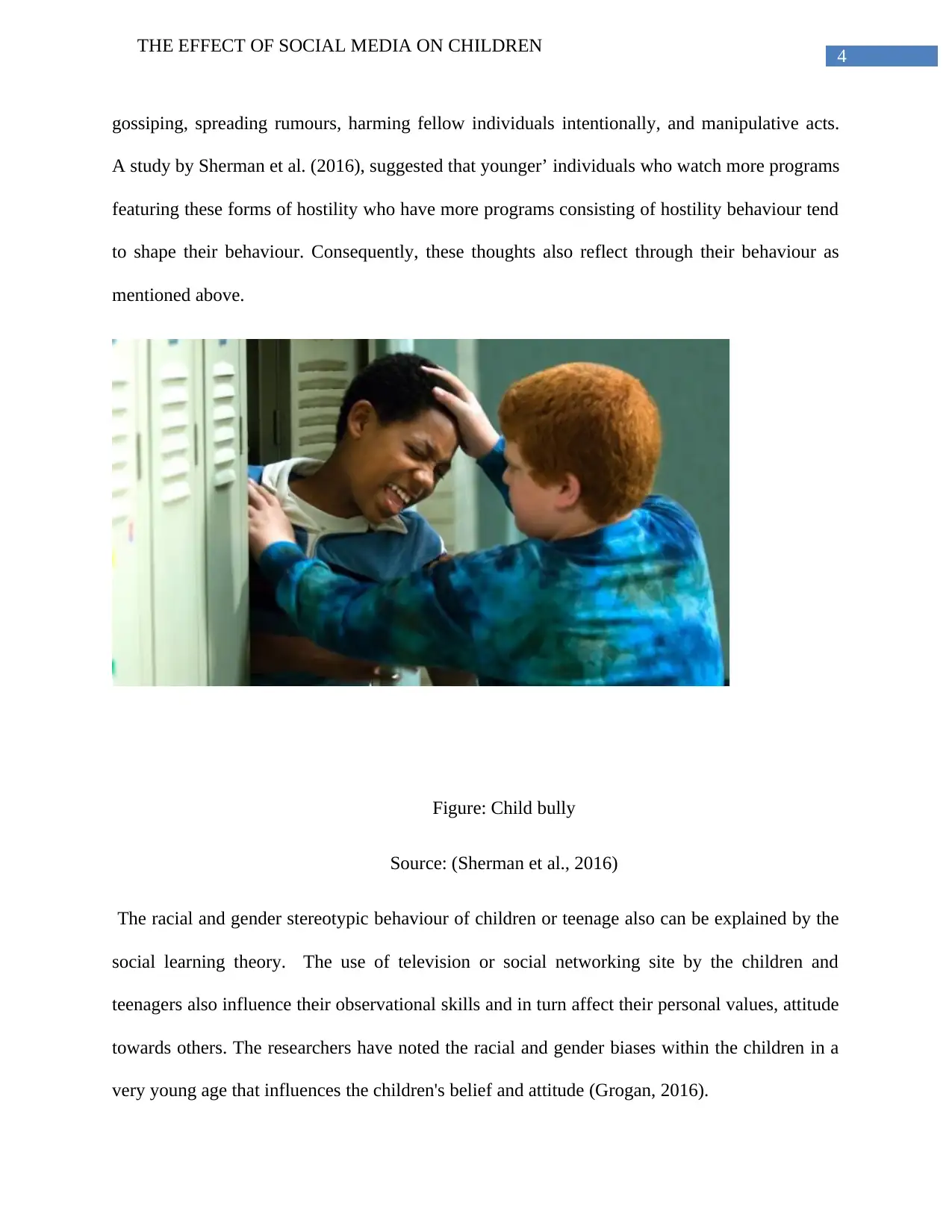
4
THE EFFECT OF SOCIAL MEDIA ON CHILDREN
gossiping, spreading rumours, harming fellow individuals intentionally, and manipulative acts.
A study by Sherman et al. (2016), suggested that younger’ individuals who watch more programs
featuring these forms of hostility who have more programs consisting of hostility behaviour tend
to shape their behaviour. Consequently, these thoughts also reflect through their behaviour as
mentioned above.
Figure: Child bully
Source: (Sherman et al., 2016)
The racial and gender stereotypic behaviour of children or teenage also can be explained by the
social learning theory. The use of television or social networking site by the children and
teenagers also influence their observational skills and in turn affect their personal values, attitude
towards others. The researchers have noted the racial and gender biases within the children in a
very young age that influences the children's belief and attitude (Grogan, 2016).
THE EFFECT OF SOCIAL MEDIA ON CHILDREN
gossiping, spreading rumours, harming fellow individuals intentionally, and manipulative acts.
A study by Sherman et al. (2016), suggested that younger’ individuals who watch more programs
featuring these forms of hostility who have more programs consisting of hostility behaviour tend
to shape their behaviour. Consequently, these thoughts also reflect through their behaviour as
mentioned above.
Figure: Child bully
Source: (Sherman et al., 2016)
The racial and gender stereotypic behaviour of children or teenage also can be explained by the
social learning theory. The use of television or social networking site by the children and
teenagers also influence their observational skills and in turn affect their personal values, attitude
towards others. The researchers have noted the racial and gender biases within the children in a
very young age that influences the children's belief and attitude (Grogan, 2016).
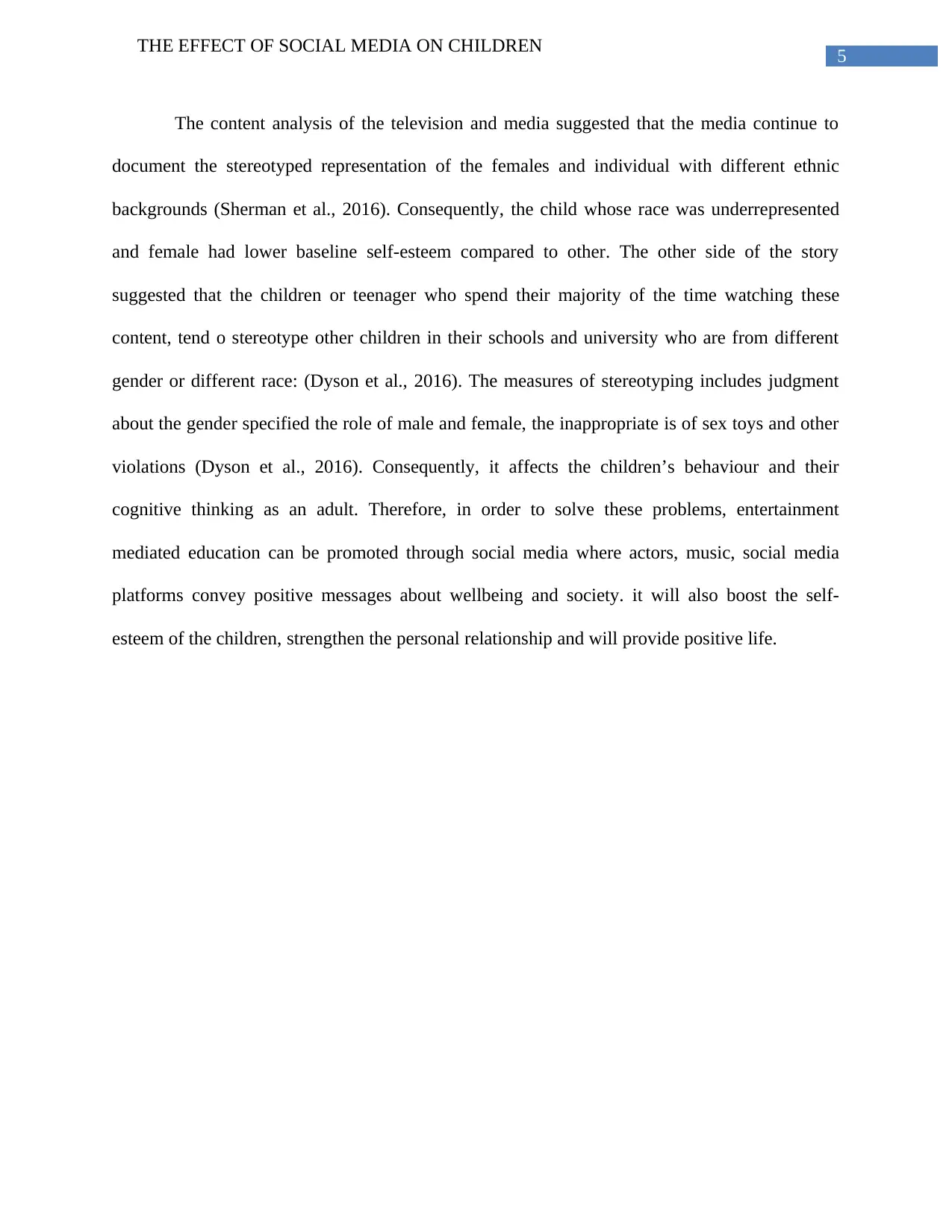
5
THE EFFECT OF SOCIAL MEDIA ON CHILDREN
The content analysis of the television and media suggested that the media continue to
document the stereotyped representation of the females and individual with different ethnic
backgrounds (Sherman et al., 2016). Consequently, the child whose race was underrepresented
and female had lower baseline self-esteem compared to other. The other side of the story
suggested that the children or teenager who spend their majority of the time watching these
content, tend o stereotype other children in their schools and university who are from different
gender or different race: (Dyson et al., 2016). The measures of stereotyping includes judgment
about the gender specified the role of male and female, the inappropriate is of sex toys and other
violations (Dyson et al., 2016). Consequently, it affects the children’s behaviour and their
cognitive thinking as an adult. Therefore, in order to solve these problems, entertainment
mediated education can be promoted through social media where actors, music, social media
platforms convey positive messages about wellbeing and society. it will also boost the self-
esteem of the children, strengthen the personal relationship and will provide positive life.
THE EFFECT OF SOCIAL MEDIA ON CHILDREN
The content analysis of the television and media suggested that the media continue to
document the stereotyped representation of the females and individual with different ethnic
backgrounds (Sherman et al., 2016). Consequently, the child whose race was underrepresented
and female had lower baseline self-esteem compared to other. The other side of the story
suggested that the children or teenager who spend their majority of the time watching these
content, tend o stereotype other children in their schools and university who are from different
gender or different race: (Dyson et al., 2016). The measures of stereotyping includes judgment
about the gender specified the role of male and female, the inappropriate is of sex toys and other
violations (Dyson et al., 2016). Consequently, it affects the children’s behaviour and their
cognitive thinking as an adult. Therefore, in order to solve these problems, entertainment
mediated education can be promoted through social media where actors, music, social media
platforms convey positive messages about wellbeing and society. it will also boost the self-
esteem of the children, strengthen the personal relationship and will provide positive life.
⊘ This is a preview!⊘
Do you want full access?
Subscribe today to unlock all pages.

Trusted by 1+ million students worldwide
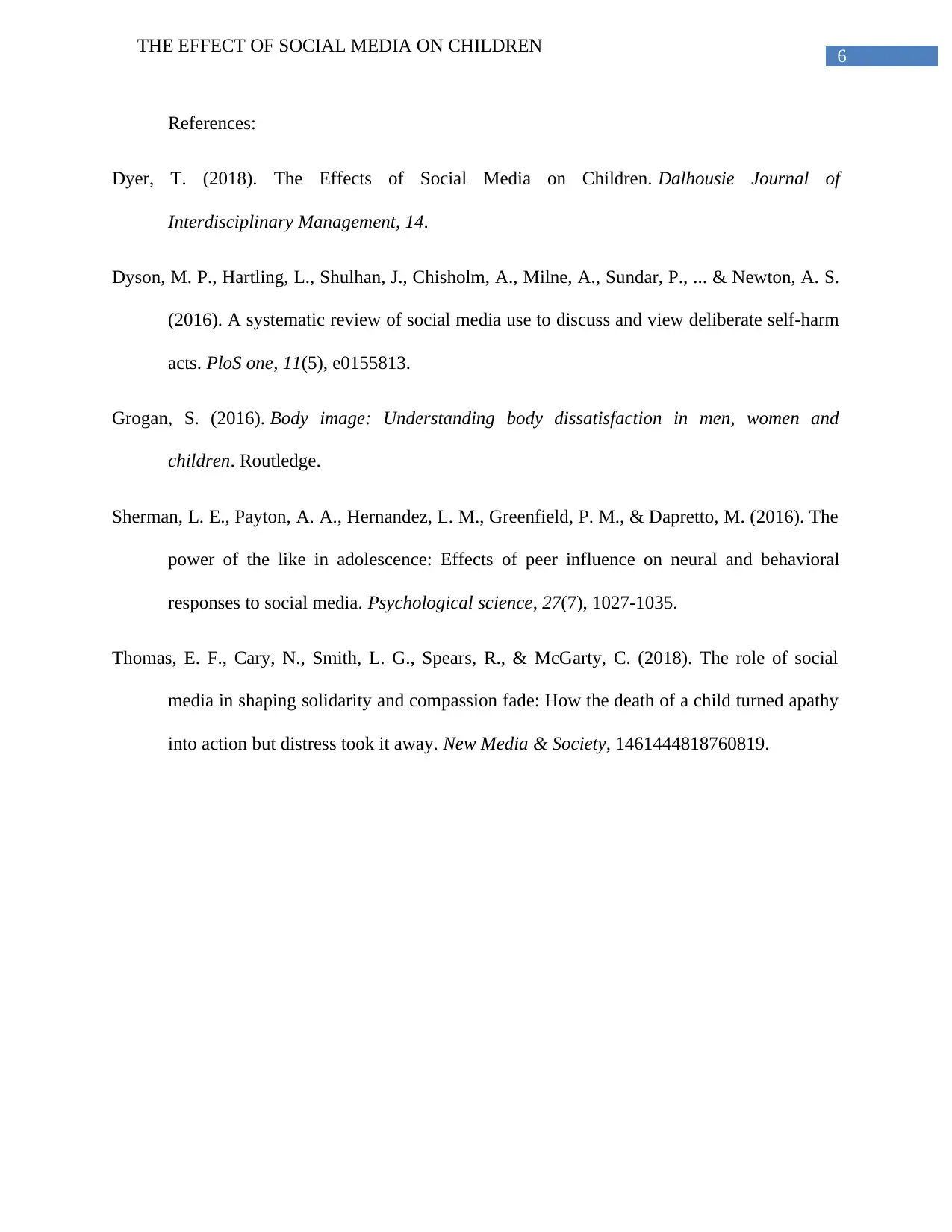
6
THE EFFECT OF SOCIAL MEDIA ON CHILDREN
References:
Dyer, T. (2018). The Effects of Social Media on Children. Dalhousie Journal of
Interdisciplinary Management, 14.
Dyson, M. P., Hartling, L., Shulhan, J., Chisholm, A., Milne, A., Sundar, P., ... & Newton, A. S.
(2016). A systematic review of social media use to discuss and view deliberate self-harm
acts. PloS one, 11(5), e0155813.
Grogan, S. (2016). Body image: Understanding body dissatisfaction in men, women and
children. Routledge.
Sherman, L. E., Payton, A. A., Hernandez, L. M., Greenfield, P. M., & Dapretto, M. (2016). The
power of the like in adolescence: Effects of peer influence on neural and behavioral
responses to social media. Psychological science, 27(7), 1027-1035.
Thomas, E. F., Cary, N., Smith, L. G., Spears, R., & McGarty, C. (2018). The role of social
media in shaping solidarity and compassion fade: How the death of a child turned apathy
into action but distress took it away. New Media & Society, 1461444818760819.
THE EFFECT OF SOCIAL MEDIA ON CHILDREN
References:
Dyer, T. (2018). The Effects of Social Media on Children. Dalhousie Journal of
Interdisciplinary Management, 14.
Dyson, M. P., Hartling, L., Shulhan, J., Chisholm, A., Milne, A., Sundar, P., ... & Newton, A. S.
(2016). A systematic review of social media use to discuss and view deliberate self-harm
acts. PloS one, 11(5), e0155813.
Grogan, S. (2016). Body image: Understanding body dissatisfaction in men, women and
children. Routledge.
Sherman, L. E., Payton, A. A., Hernandez, L. M., Greenfield, P. M., & Dapretto, M. (2016). The
power of the like in adolescence: Effects of peer influence on neural and behavioral
responses to social media. Psychological science, 27(7), 1027-1035.
Thomas, E. F., Cary, N., Smith, L. G., Spears, R., & McGarty, C. (2018). The role of social
media in shaping solidarity and compassion fade: How the death of a child turned apathy
into action but distress took it away. New Media & Society, 1461444818760819.
1 out of 7
Related Documents
Your All-in-One AI-Powered Toolkit for Academic Success.
+13062052269
info@desklib.com
Available 24*7 on WhatsApp / Email
![[object Object]](/_next/static/media/star-bottom.7253800d.svg)
Unlock your academic potential
Copyright © 2020–2025 A2Z Services. All Rights Reserved. Developed and managed by ZUCOL.





